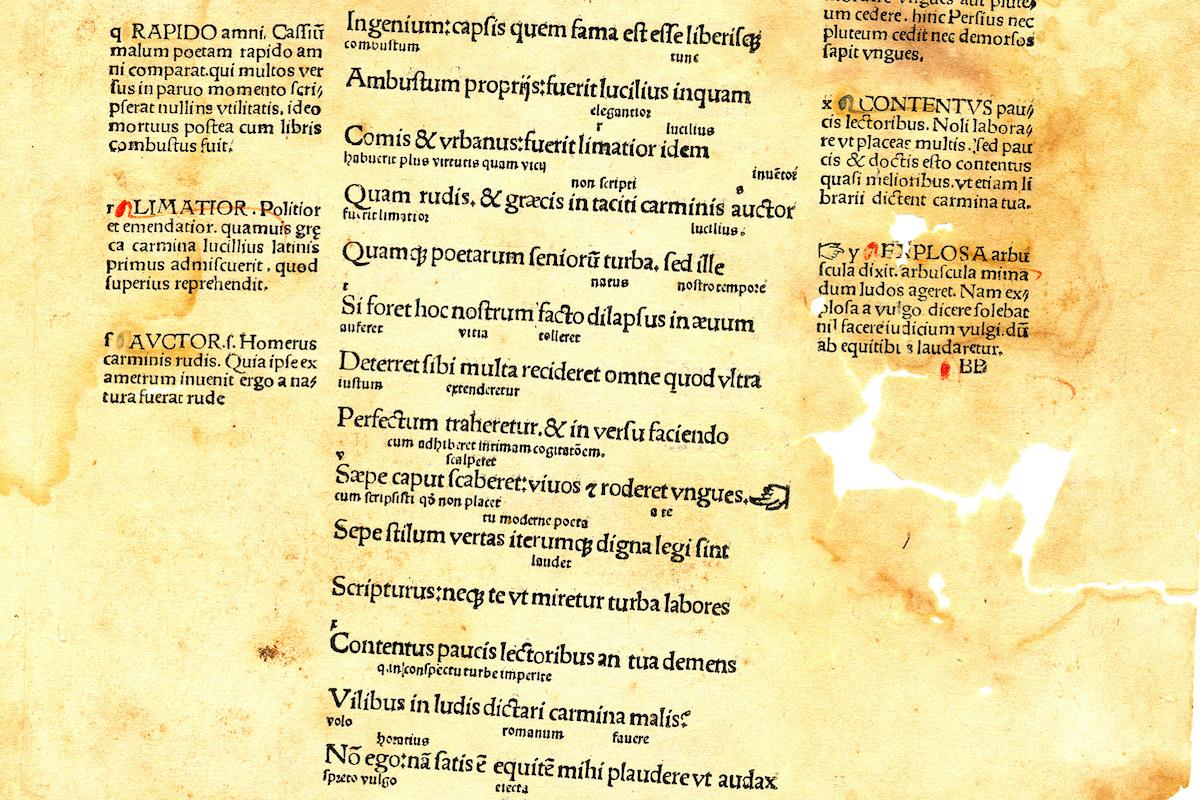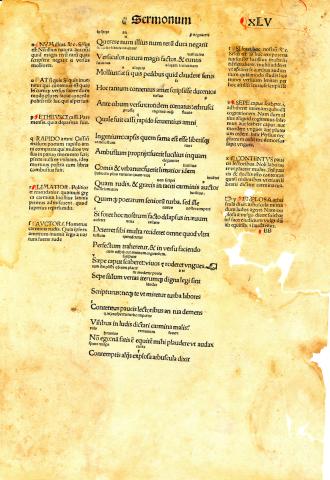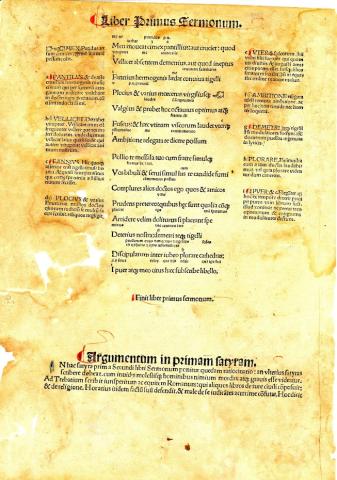Leaf from Horace's Opera
Leaf from Horace's Opera, 1st illustrated edition
German Renaissance
Strasbourg, March 1498
Printer: Johannes (Hans) Grüninger
Editor: Jakob Locher
Portland State University Library Special Collections, Shipley 12
Dryden Forbes, Medieval Capstone Student, 2016
This leaf contains lines 57-92 of Horace’s satire 1.10. On the top right of the recto is printed XLV.[1] Printed commentaries occupy the margins on both sides of the leaf. On the bottom of the verso is a summary of satire 1.10, probably provided by the humanist and poet laureate under King Maximilian, Jakob Locher, who was also responsible for the commentary in the margins.[2] The summary explains Horace’s general concern about satire and the issues that some people have with satire, according to Horace (they are “excessively sharp and weighty”). In Satire 1.10, Horace discusses what satire should be and, on this particular leaf, states that he does not wish his work to achieve mass circulation but is content if his close circle of friends finds it pleasing.[3] In between the lines of the poem are words printed in smaller, gothic type that is used to clarify some of the words or names used). This suggests that Opera was intended for pedagogical purposes, given the great number of these notes in between the lines that might help guide a less familiar reader with some of the conventions of Latin poetry. The rest of the type, including the commentary, is in Roman typeface. Horace’s work had a tradition within the educational sphere in medieval Europe, and it seems as if Locher has that tradition in mind with this edition given the extensive commentaries.[4] This is not typical of Renaissance prints of Horace; however, he seemed to find less popularity in the field of education and more popularity among poets like Petrarch, who found inspiration in his work.[5]
Johannes Grüninger largely printed Catholic works such as breviaries, missals, and a German Bible, but for a few years (1496-1502) produced some of the well-known classics: Terence’s Comidiae in 1496, Horace’s Opera in 1498, and Vergil’s Aeneid in 1502.[6] His edition of Horace is the most notable in that it is the first edition to be printed with illustrations. It is also the only edition of Horace to be printed with commentary before 1500.[7] It contains 101 new woodcuts out of 623 total. The rest of the woodcuts were recycled from older publications (49 are from his edition of Terence).[8] Despite the damage that this leaf has sustained, it is a beautiful piece that speaks to Horace’s importance as a poet and his importance to Renaissance scholars.
NOTES
[1] Mark P.O. Morford, Syntagmatia: Essays on Neo-Latin Literature in Honour of Monique Mund-Dopchie and Gilbert Tournoy. Ed. Dirk Sacré and Jan Papy, (Leuven: Leuven University Press, 2009), 129.
[2] Christoph Pieper, Transformations of the Early Modern Classics via Early Modern Commentaries, ed. Karl A.E. Enekel, (Lieden: Koninklijke Brill NV, 2014), 61
[3] Horace, Satires and Epistles, trans. Niall Rudd, (London: Penguin Group, 1979), 79-82.
[4] Suzanne Reynolds, Medieval Reading: Grammar Rhetoric and the Classical Text, (Cambridge: Cambridge University Press, 1996), 14.
[5] Susan Harrison, The Cambridge Companion to Horace, (New York: The Cambridge University Press, 2007), 305
[6] E.P. Goldschmidt, The Printed Book of the Renaissance: Three Lectures on Type, Illustration, Ornament, (Amsterdam: Gérard Th van Heusden, 1966), 47
[7] Grant Showerman, Horace and His Influence, (Boston: Marshall Jones Company, 1922), 116.
[8] Mark P.O. Morford Syntagmatia. 129.
BIBLIOGRAPHY
Goldschmidt, E.P. The Printed Book of the Renaissance: Three Lectures on Type, Illustration, Ornament. Second edition. Amsterdam: Gérard Th. van Heusden, 1966.
Harrison, Susan. The Cambridge Companion to Horace. New York: The Cambridge University Press, 2007. Print.
Horace. Satires and Epistles. Translated by Niall Rudd. London: Penguin Group, 1979.
Morford, Mark P.O. Syntagmatia: Essays on Neo-Latin Literature in Honour of Monique Mund-Dopchie and Gilbert Tournoy, Edited by Dirk Sacré and Jan Papy. Leuven: Leuven University Press, 2009.
Pieper, Christoph. Transformations of the Early Modern Classics via Early Modern Commentaries, Edited by Karl A.E. Enekel. Lieden: Koninklijke Brill NV, 2014. Print
Reynolds, Suzanne. Medieval Reading: Grammar Rhetoric and the Classical Text. Cambridge: Cambridge University Press, 1996. Print
Showerman, Grant. Horace and His Influence. Boston: Marshall Jones Company, 1922. pp Print.




